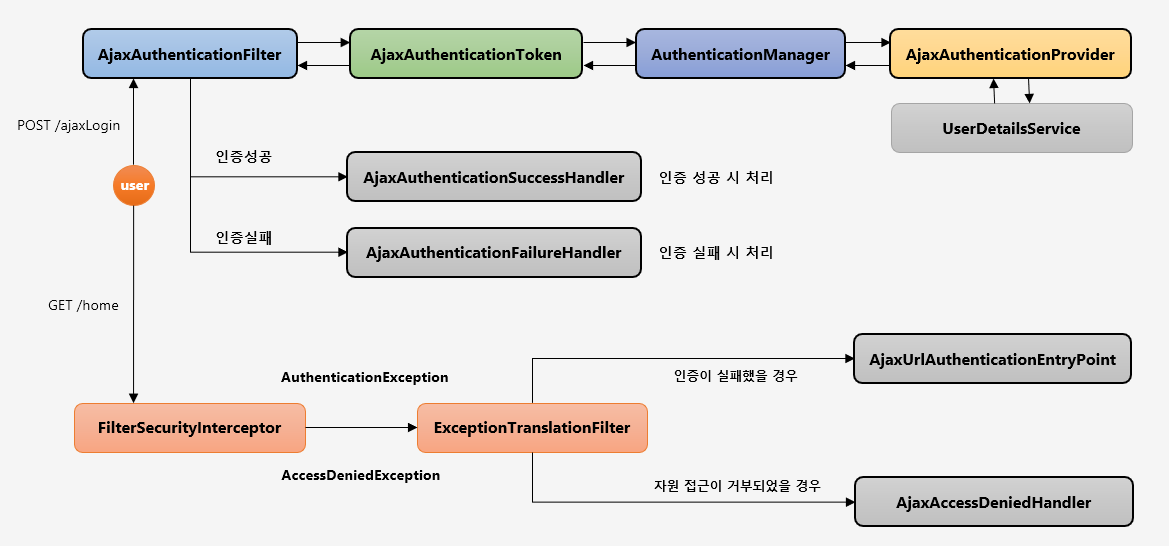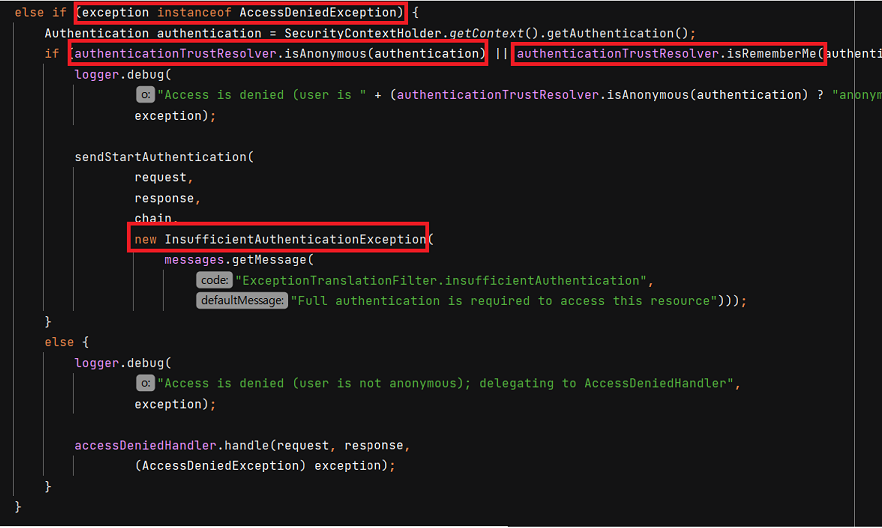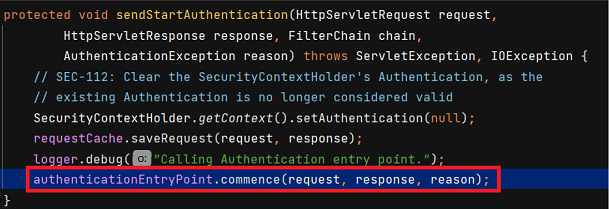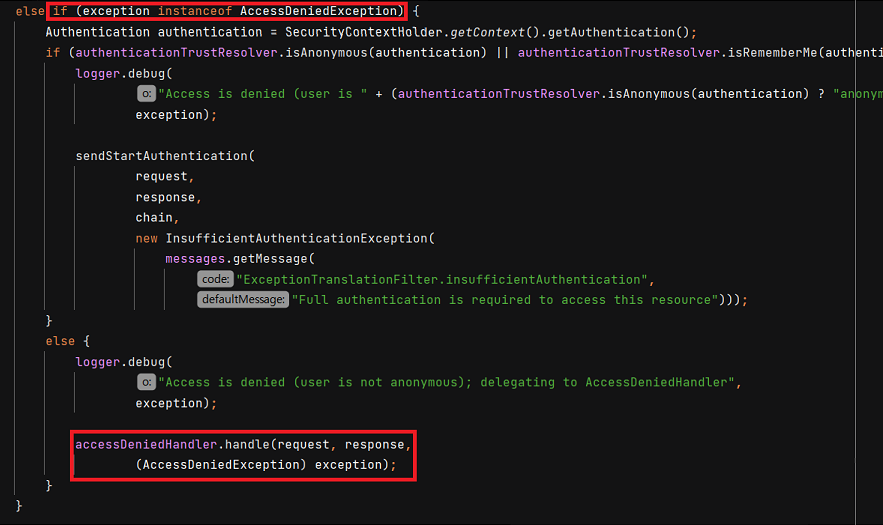- [Spring Security] Section 1. 스프링 시큐리티 기본 API 및 Filter
- [Spring Security] Section 2. 주요 아키텍처 이해
- [Spring Security] Section 3. 인증 프로세스 Form 인증 구현
- [Spring Security] Section 4. Ajax 인증 구현
- [Spring Security] Section 5. 인가 프로세스 DB 연동 웹계층
- [Spring Security] Section 6. Method 기반 DB 연동
[Spring Security] Section 4. Ajax 인증 구현
Ajax 인증 흐름

Ajax 인증은 AjexAuthenticationFilter 에서 시작됩니다. Form 인증 방식의 흐름과 크게 다르지 않습니다.
AjaxAuthenticationFilter
직접 AjaxAuthenticationFilter 를 만들기 위해서는 AbstractAuthenticationProcessingFilter 를 상속받아야 합니다. 필터의 작동조건은 요청정보와 매칭하고 요청방식이 Ajax 면 필터가 작동되도록 합니다. AjaxAuthenticationToken 을 생성하여 AuthenticationManger 에서 전달하여 인증처리를 합니다.
Filter 를 추가해야 하는데, http.addFilterBefore(AjaxAuthenticationFilter(), UsernamePasswordAuthenticationFilter.class) 로 추가를 합니다.
AjaxLoginProcessingFilter 만들기
public class AjaxLoginProcessingFilter extends AbstractAuthenticationProcessingFilter {
private ObjectMapper objectMapper = new ObjectMapper();
public AjaxLoginProcessingFilter() {
super(new AntPathRequestMatcher("/api/login"));
}
@Override
public Authentication attemptAuthentication(HttpServletRequest request, HttpServletResponse response) throws AuthenticationException, IOException, ServletException {
if(!isAjax(request)){
throw new IllegalStateException("Authentication is not supported");
}
AccountDto accountDto = objectMapper.readValue(request.getReader(), AccountDto.class);
if(StringUtils.isEmpty(accountDto.getUsername()) || StringUtils.isEmpty(accountDto.getPassword())){
throw new IllegalArgumentException("Username or Password is empty");
}
AjaxAuthenticationToken ajaxAuthenticationToken = new AjaxAuthenticationToken(accountDto.getUsername(), accountDto.getPassword());
return getAuthenticationManager().authenticate(ajaxAuthenticationToken);
}
private boolean isAjax(HttpServletRequest request) {
if("XMLHttpRequest".equals(request.getHeader("X-Requested-With"))){
return true;
}
return false;
}
}
attemptAuthentication 에서 isAjax() 메서드로 Ajax 요청인지 아닌지 확인합니다. 그리고 AccountDto 를 만들고 해당 Dto 를 AjaxAuthenticationToken 으로 만듭니다. 마지막으로 getAuthenticationManager().authenticate(ajaxAuthenticationToken); 으로 가지고 있는 AuthenticationManager 에게 인증을 위임합니다.
AjaxAuthenticationToken 만들기
위에서 사용된 AjaxAuthenticationToken 를 만들어보겠습니다.
public class AjaxAuthenticationToken extends AbstractAuthenticationToken {
private static final long serialVersionUID = SpringSecurityCoreVersion.SERIAL_VERSION_UID;
private final Object principal;
private Object credentials;
public AjaxAuthenticationToken(Object principal, Object credentials) {
super(null);
this.principal = principal;
this.credentials = credentials;
setAuthenticated(false);
}
public AjaxAuthenticationToken(Object principal, Object credentials,
Collection<? extends GrantedAuthority> authorities) {
super(authorities);
this.principal = principal;
this.credentials = credentials;
super.setAuthenticated(true); // must use super, as we override
}
public Object getCredentials() {
return this.credentials;
}
public Object getPrincipal() {
return this.principal;
}
public void setAuthenticated(boolean isAuthenticated) throws IllegalArgumentException {
if (isAuthenticated) {
throw new IllegalArgumentException(
"Cannot set this token to trusted - use constructor which takes a GrantedAuthority list instead");
}
super.setAuthenticated(false);
}
@Override
public void eraseCredentials() {
super.eraseCredentials();
credentials = null;
}
}
해당 로직은 UsernamePasswordAuthenticationToken 에서 가지고 왔습니다. 해당 토큰도 AbstractAuthenticationToken 를 상속받고 있습니다.
AjaxAuthenticationProvider
이제 AuthenticationProvider 를 만들어야 합니다. 현재 AuthenticationManager 가 가지고 있는 Provider 중 AjaxAuthenticationToken 을 처리할 수 있는 Provider 가 없기 때문입니다.
AjaxAuthenticationProvider 은 이전 챕터에서 만들었던 FormAuthenticationProvider 와 유사합니다.
public class AjaxAuthenticationProvider implements AuthenticationProvider {
@Autowired private UserDetailsService userDetailsService;
@Autowired private PasswordEncoder passwordEncoder;
@Override
@Transactional
public Authentication authenticate(Authentication authentication) throws AuthenticationException {
String loginId = authentication.getName();
String password = (String) authentication.getCredentials();
AccountContext accountContext = (AccountContext) userDetailsService.loadUserByUsername(loginId);
if (!passwordEncoder.matches(password, accountContext.getPassword())) {
throw new BadCredentialsException("Invalid password");
}
return new AjaxAuthenticationToken(accountContext.getAccount(), null, accountContext.getAuthorities());
}
@Override
public boolean supports(Class<?> authentication) {
return authentication.equals(AjaxAuthenticationToken.class);
}
}
supports 를 통해 AjaxAuthenticationToken 을 처리할 수 있도록 합니다.
AjaxSecurityConfig
마지막으로 설정 정보를 업데이트하겠습니다.
@Override
protected void configure(AuthenticationManagerBuilder auth) throws Exception {
auth.authenticationProvider(ajaxAuthenticationProvider());
}
@Bean
public AuthenticationProvider ajaxAuthenticationProvider() {
return new AjaxAuthenticationProvider();
}
@Override
protected void configure(HttpSecurity http) throws Exception {
http
.antMatcher("/api/**")
.authorizeRequests()
.antMatchers("/api/messages").hasRole("MANAGER")
.anyRequest().authenticated()
.and()
.addFilterBefore(ajaxLoginProcessingFilter(), UsernamePasswordAuthenticationFilter.class);
http.csrf().disable();
}
@Bean
public AjaxLoginProcessingFilter ajaxLoginProcessingFilter() throws Exception {
AjaxLoginProcessingFilter ajaxLoginProcessingFilter = new AjaxLoginProcessingFilter();
ajaxLoginProcessingFilter.setAuthenticationManager(authenticationManagerBean());
return ajaxLoginProcessingFilter;
}
먼저 AuthenticationManagerBuilder 에 AjaxAuthenticationProvider 를 등록해줍니다.
그리고 addFilterBefore() 메서드로 UsernamePasswordAuthenticationFilter 이전에 ajaxLoginProcessingFilter 가 적용되도록 했습니다. setAuthenticationManager() 메서드로 AuthenticationManager 를 등록해야 합니다. authenticationManagerBean() 은 WebSecurityConfigurerAdapter 에서 제공합니다.
또한 POST 방식으로 보내려면 csrf 토큰이 있어야 하는데, ajax 방식으로 해당 토큰을 보내지 않으므로 http.csrf().disable() 로 비활성화합니다.
# 인증 핸들러 - AjaxAuthenticationSuccessHandler, AjaxAuthenticationFailureHandler
이번에는 만들어둔 AjaxLoginProcessingFilter 에 AjaxAuthenticationSuccessHandler 와 AjaxAuthenticationFailureHandler 을 붙이겠습니다.
AjaxAuthenticationSuccessHandler
public class AjaxAuthenticationSuccessHandler implements AuthenticationSuccessHandler {
private ObjectMapper objectMapper = new ObjectMapper();
@Override
public void onAuthenticationSuccess(HttpServletRequest request, HttpServletResponse response, Authentication authentication) throws IOException, ServletException {
Account account = (Account)authentication.getPrincipal();
response.setStatus(HttpStatus.OK.value());
response.setContentType(MediaType.APPLICATION_JSON_VALUE);
objectMapper.writeValue(response.getWriter(), account);
}
}
해당 핸들러는 인증 성공 시 처리로직입니다. response 에 Status 와 ContentType 을 지정하고 응답값으로 account 를 보냅니다.
AjaxAuthenticationFailureHandler
public class AjaxAuthenticationFailureHandler implements AuthenticationFailureHandler {
private ObjectMapper objectMapper = new ObjectMapper();
@Override
public void onAuthenticationFailure(HttpServletRequest request, HttpServletResponse response, AuthenticationException exception) throws IOException, ServletException {
String errMsg = "Invalid Username or Password";
response.setStatus(HttpStatus.UNAUTHORIZED.value());
response.setContentType(MediaType.APPLICATION_JSON_VALUE);
if(exception instanceof BadCredentialsException) {
errMsg = "Invalid Username or Password";
} else if(exception instanceof DisabledException) {
errMsg = "Locked";
} else if(exception instanceof CredentialsExpiredException) {
errMsg = "Expired password";
}
objectMapper.writeValue(response.getWriter(), errMsg);
}
}
해당 핸들러는 인증 실패 시 처리로직입니다. errMsg 을 응답값으로 보냅니다.
AjaxSecurityConfig
@Configuration
@Order(0)
public class AjaxSecurityConfig extends WebSecurityConfigurerAdapter {
...
@Bean
public AuthenticationSuccessHandler ajaxAuthenticationSuccessHandler(){
return new AjaxAuthenticationSuccessHandler();
}
@Bean
public AuthenticationFailureHandler ajaxAuthenticationFailureHandler(){
return new AjaxAuthenticationFailureHandler();
}
@Bean
public AjaxLoginProcessingFilter ajaxLoginProcessingFilter() throws Exception {
AjaxLoginProcessingFilter ajaxLoginProcessingFilter = new AjaxLoginProcessingFilter();
ajaxLoginProcessingFilter.setAuthenticationManager(authenticationManagerBean());
ajaxLoginProcessingFilter.setAuthenticationSuccessHandler(ajaxAuthenticationSuccessHandler());
ajaxLoginProcessingFilter.setAuthenticationFailureHandler(ajaxAuthenticationFailureHandler());
return ajaxLoginProcessingFilter;
}
}
이제 만들어둔 핸들러를 수동으로 빈등록한 후에 ajaxLoginProcessingFilter 에 추가합니다.
인증 예외 처리 - AjaxLoginUrlAuthenticationEntryPoint
ExcetionTranslationFilter 는 인증을 받지 않은 사용자에 대해서 다음과 같이 로직을 처리합니다. 아래는 handleSpringSecurityException() 메서드 중 일부입니다.

잘 보면 AccessDeniedException 이지만 Anonymous 혹은 rememberMe 일 때 sendStartAuthentication() 메서드를 호출하면서 InsufficientAuthenticationException 을 보냅니다.
해당 메서드에서는 Authentication 을 삭제하고 ReuqestCache 에 응답을 저장한 뒤 등록된 AuthenticationEntryPoint 의 commence() 를 호출합니다.

따라서 AjaxLoginUrlAuthenticationEntryPoint 를 만드는건 AuthenticationEntryPoint 를 상속받은 클래스에서 commence() 메서드를 오버라이딩하는 것입니다.
아래는 AjaxLoginUrlAuthenticationEntryPoint 클래스입니다.
public class AjaxLoginAuthenticationEntryPoint implements AuthenticationEntryPoint {
@Override
public void commence(HttpServletRequest request, HttpServletResponse response, AuthenticationException authException) throws IOException, ServletException {
response.sendError(HttpServletResponse.SC_UNAUTHORIZED,"UnAuthorized");
}
}
response 에 에러응답을 실어서 보내게 됩니다.
등록은 아래 AjaxAccessDeniedHandler 에서 같이 하도록 하겠습니다.
인증 예외 처리 - AjaxAccessDeniedHandler
이번엔 ExcetionTranslationFilter 에서 인가받지 않은 사용자를 처리할 때 handleSpringSecurityException() 메서드의 동작입니다.

AccessDeiniedException 이면서 익명 사용자나 rememberMe 가 아닐 때 AccessDeniedHandler 의 handle() 메서드를 호출합니다. AccessDeniedHandler 를 직접 구현할 수 있습니다.
아래는 AccessDeniedHandler 클래스입니다.
public class AjaxAccessDeniedHandler implements AccessDeniedHandler {
@Override
public void handle(HttpServletRequest request, HttpServletResponse response, AccessDeniedException accessDeniedException) throws IOException, ServletException {
response.sendError(HttpServletResponse.SC_FORBIDDEN, "Access is denied");
}
}
response 에 403 에러를 실어서 보내게 됩니다.
SecurityConfig 구성
@Override
protected void configure(HttpSecurity http) throws Exception {
http
.antMatcher("/api/**")
.authorizeRequests()
.antMatchers("/api/messages").hasRole("MANAGER")
.anyRequest().authenticated()
.and()
.addFilterBefore(ajaxLoginProcessingFilter(), UsernamePasswordAuthenticationFilter.class);
http
.exceptionHandling()
.authenticationEntryPoint(new AjaxLoginAuthenticationEntryPoint()) //authenticationEntryPoint 등록
.accessDeniedHandler(ajaxAccessDeniedHandler()); //accessDeniedHandler 등록
http.csrf().disable();
}
public AccessDeniedHandler ajaxAccessDeniedHandler() {
return new AjaxAccessDeniedHandler();
}
AjaxLoginAuthenticationEntryPoint 와 AjaxAccessDeniedHandler 를 동록할 떄는 DI 기능을 사용할 필요가 없으므로 빈으로 등록할 필요는 없습니다.
Ajax Custom DSLs 구현
DSL 란 도메인 특화 언어로, 특정한 도메인을 적용하는 데 특화된 컴퓨터 언어입니다. Spring Security 의 Custom DSL 를 구현하기 위해서는 AbstractHttpConfigurer 를 구현하면 됩니다.
public final class AjaxLoginConfigurer<H extends HttpSecurityBuilder<H>> extends
AbstractAuthenticationFilterConfigurer<H, AjaxLoginConfigurer<H>, AjaxLoginProcessingFilter> {
private AuthenticationSuccessHandler successHandler;
private AuthenticationFailureHandler failureHandler;
private AuthenticationManager authenticationManager;
public AjaxLoginConfigurer() {
super(new AjaxLoginProcessingFilter(), null);
}
@Override
public void init(H http) throws Exception {
super.init(http);
}
@Override
public void configure(H http) {
if(authenticationManager == null){
authenticationManager = http.getSharedObject(AuthenticationManager.class);
}
getAuthenticationFilter().setAuthenticationManager(authenticationManager);
getAuthenticationFilter().setAuthenticationSuccessHandler(successHandler);
getAuthenticationFilter().setAuthenticationFailureHandler(failureHandler);
SessionAuthenticationStrategy sessionAuthenticationStrategy = http
.getSharedObject(SessionAuthenticationStrategy.class);
if (sessionAuthenticationStrategy != null) {
getAuthenticationFilter().setSessionAuthenticationStrategy(sessionAuthenticationStrategy);
}
RememberMeServices rememberMeServices = http
.getSharedObject(RememberMeServices.class);
if (rememberMeServices != null) {
getAuthenticationFilter().setRememberMeServices(rememberMeServices);
}
http.setSharedObject(AjaxLoginProcessingFilter.class,getAuthenticationFilter());
http.addFilterBefore(getAuthenticationFilter(), UsernamePasswordAuthenticationFilter.class);
}
public AjaxLoginConfigurer<H> successHandlerAjax(AuthenticationSuccessHandler successHandler) {
this.successHandler = successHandler;
return this;
}
public AjaxLoginConfigurer<H> failureHandlerAjax(AuthenticationFailureHandler authenticationFailureHandler) {
this.failureHandler = authenticationFailureHandler;
return this;
}
public AjaxLoginConfigurer<H> setAuthenticationManager(AuthenticationManager authenticationManager) {
this.authenticationManager = authenticationManager;
return this;
}
@Override
protected RequestMatcher createLoginProcessingUrlMatcher(String loginProcessingUrl) {
return new AntPathRequestMatcher(loginProcessingUrl, "POST");
}
}
그리고 AjaxSecurityConfig 에 등록합니다.
@Override
protected void configure(HttpSecurity http) throws Exception {
http
.antMatcher("/api/**")
.authorizeRequests()
.antMatchers("/api/messages").hasRole("MANAGER")
.antMatchers("/api/login").permitAll()
.anyRequest().authenticated()
.and()
.exceptionHandling()
.authenticationEntryPoint(new AjaxLoginAuthenticationEntryPoint())
.accessDeniedHandler(ajaxAccessDeniedHandler())
;
http.csrf().disable();
customConfigurerAjax(http); //등록
}
private void customConfigurerAjax(HttpSecurity http) throws Exception {
http
.apply(new AjaxLoginConfigurer<>())
.successHandlerAjax(ajaxAuthenticationSuccessHandler())
.failureHandlerAjax(ajaxAuthenticationFailureHandler())
.setAuthenticationManager(authenticationManagerBean())
.loginProcessingUrl("/api/login");
}
각각의 핸들러는 AjaxSecurityConfig 내에서 구현하면 됩니다. 만약 default 로 설정하려면 AbstractHttpConfigurer 에 넣어두면 되겠죠.



댓글남기기